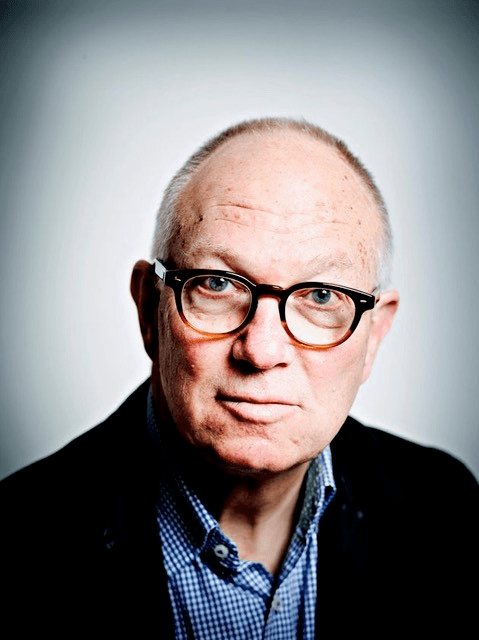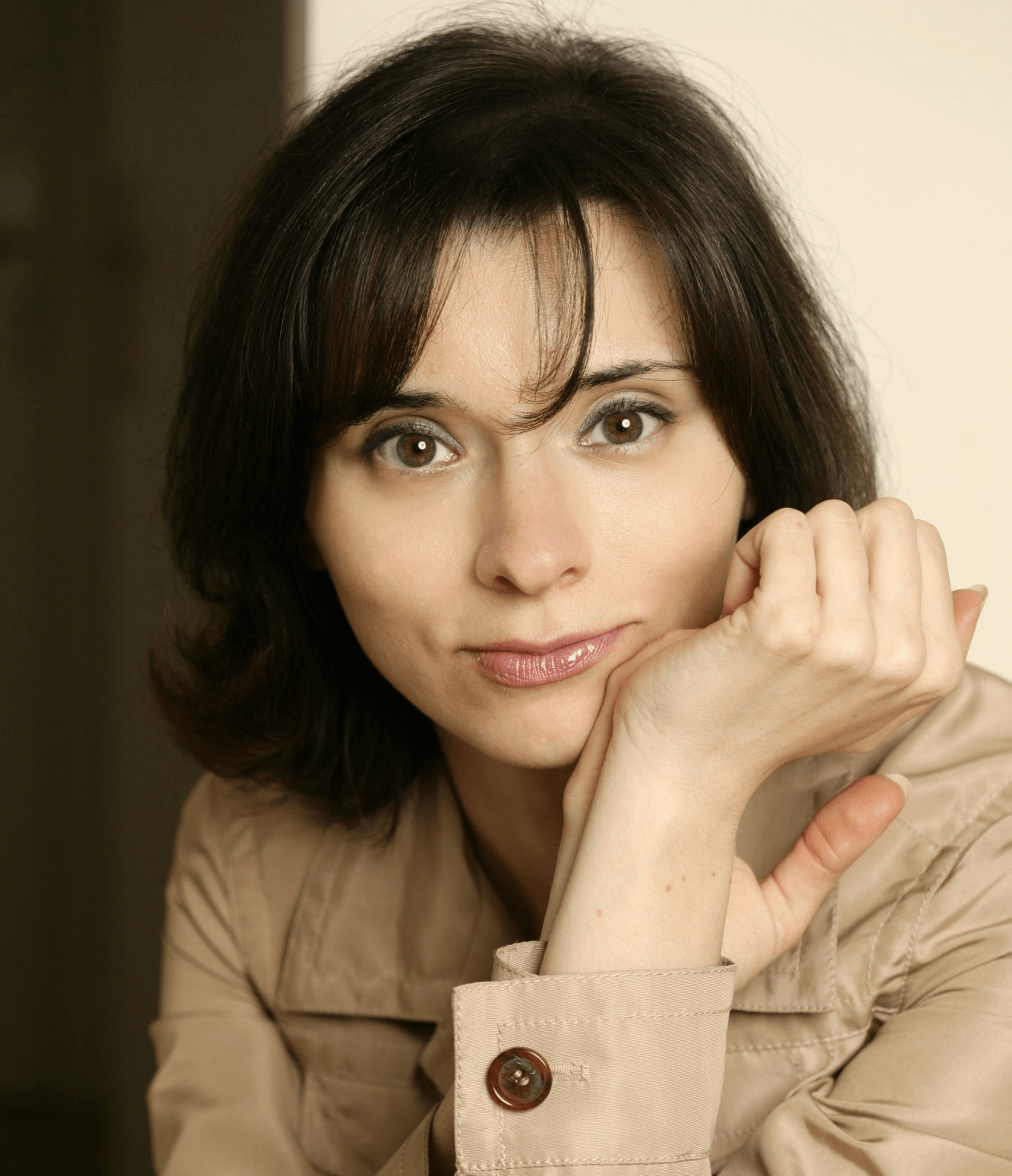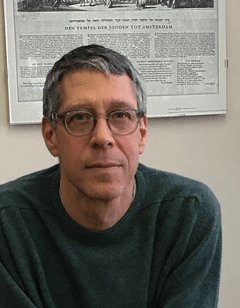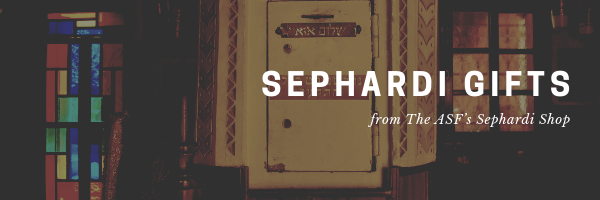Mabrouk/Mazal Tov to our friends and partners the Muslim American Leadership Alliance (MALA), on ringing the Nasdaq’s Opening Bell! The ASF was honored to be a part of the delegation.
Click here to dedicate a future issue in honor or memory of a loved one
Upcoming Events ◊ ASF Sephardi Shop ◊ Donate ◊ Sephardi Ideas Monthly ◊ ASF IJE ◊ ASF Sephardi House ◊ Archive
The Sephardi World Weekly is made possible by Daniel Yifrach, Rachel Sally, Professor Rifka Cook, Maria Gabriela Borrego Medina, Rachel Amar, Deborah Arellano, & ASF VP Gwen Zuares!
Join the Sephardi World Weekly Global Design Competition!
“Finally, a new hub for people who want to study the language and history of Ladino”
By Aviya Kushner, Forward
Bryan Kirschen, co-curator of the ASF’s NY Ladino Day, Bendichas Manos: 7th Anniversary Event, Leo and Julia Forchheimer Auditorium, Center for Jewish History, 21 January 2024
Interest in learning Ladino online skyrocketed during Covid but, according to Bryan Kirschen, a professor of Hispanic Linguistics at Binghamton University and co-curator of the ASF’s New York Ladino Day, there isn’t a “national coordinating body to support language learning specifically.” Meet “The American Ladino League” (ALL) a “new hub for Ladino language learning and community” that Kirschen is co-directing:
In founding the American Ladino League, we are creating a hub that brings together people who already speak or want to learn Ladino, as well as those who are interested in learning about the language and its historic role in Sephardic culture.
Hannah Pressman, co-director of ALL, notes how study of Ladino can connect different generations:
I am a heritage speaker; my mother’s family is from Turkey and the island of Rhodes… However, in many Sephardic communities, Ladino skipped a generation or two: It wasn’t taught formally or passed down informally because people were trying to assimilate into the majority culture — much like Yiddish in America… So when I study Ladino, I am learning things that I can share not just with my kids, but also with my mom, who is now learning the language for the first time.
Remembering the Forgotten Jewish Refugees: Sephardi House Fellows Tell Their Family Stories
ASF-World Jewish Congress’ 30 November event, “Remembering the Forgotten Jewish Refugees,” Moise Safra Center, 28 November 2023
The ASF’s Sephardi House Fellowship is designed to immerse Jewish college students in the intellectual and cultural legacy of the Sephardic tradition and to bring all Jews together by infusing the warmth and wisdom of the Sephardic experience into Jewish life on campus. Four Sephardi House fellows past and present participated in a panel discussion at the ASF-World Jewish Congress’ 30 November event, “Remembering the Forgotten Jewish Refugees,” commemorating the mass exodus and expulsion of Jews from the Middle East and North Africa in the 20th century, and the connection between past and present antisemitism. In a conversation moderated by the ASF’s National Director of Sephardi House and Young Leadership, Ruben Shimonov, Yael Canaan (Carnegie Mellon), Julie Saadia (Baruch), Tehila Soleimani (Fashion Institute of Technology), and Rochelle Dweck (Syracuse) shared stories of their families’ escape from Yemen, Syria, Iran, and Egypt.
“Smaller and Greater: Thoughts for Parashat Vayakhel”
By Rabbi Marc D. Angel, Institute for Jewish Ideas and Ideals
A wise heart as rendered by AI
Reflecting on the role that synagogues can play in enhancing moral fibre, Rabbi Marc D. Angel sketches a vision of prayer that extends beyond ritual punctiliousness and communal bonding:
One who attends synagogue services should feel as though he/she has grown in the process, that he/she is stronger, better, more inspired, more courageous. ‘I’m not as small after synagogue as I am before synagogue.’
How can synagoguge services strengthen us? R’Angel finds a hint in last week’s Torah portion read yesterday, Vayakhel, and the description of the building of the Mishkan, the original man-made but Divinely-delineated prayer space. R’ Angel notes that God called upon the "wise of heart" to lead the work. Who are the “wise of heart?” They are those with “an aesthetic sense… receptive and imaginative, whose hearts were in tune with the history and destiny of their people.” The “wise of heart” are people graced with “spiritual wisdom [and]…the humility and profundity of feeling God’s presence.”
R’Angel urges us to “draw on the lessons of the ancient Mishkan” and the example of the “wise of heart”:
We, too, need to have wise hearts. We, too, need to increase our sensitivity to the holy and to the transcendent… The rabbi, hazzan and congregation come together to elevate each other, to help all of us strengthen our character, and to gain spiritual and moral uplift from communal prayer and study.
~~~~~~~
Maimonides, Spinoza and Us: Toward an Intellectually Vibrant Judaism
By Rabbi Marc D. Angel
A challenging look at two great Jewish philosophers, and what their thinking means to our understanding of God, truth, revelation and reason. Moses Maimonides (1138–1204) is Jewish history’s greatest exponent of a rational, philosophically sound Judaism. He strove to reconcile the teachings of the Bible and rabbinic tradition with the principles of Aristotelian philosophy, arguing that religion and philosophy ultimately must arrive at the same truth. Baruch Spinoza (1632–77) is Jewish history’s most illustrious “heretic.” He believed that truth could be attained through reason alone, and that philosophy and religion were separate domains that could not be reconciled. His critique of the Bible and its teachings caused an intellectual and spiritual upheaval whose effects are still felt today. Rabbi Marc D. Angel discusses major themes in the writings of Maimonides and Spinoza to show us how modern people can deal with religion in an intellectually honest and meaningful way. From Maimonides, we gain insight on how to harmonize traditional religious belief with the dictates of reason. From Spinoza, we gain insight into the intellectual challenges which must be met by modern believers.
Spinoza: Freedom's Messiah (Jewish Lives)
By Ian Buruma
Baruch (Benedictus) Spinoza (1632–1677) was a radical free thinker who led a life guided by strong moral principles despite his disbelief in an all-seeing God. Seen by many—Christians as well as Jews—as Satan’s disciple during his lifetime, Spinoza has been regarded as a secular saint since his death. Many contradictory beliefs have been attached to his name: rationalism or metaphysics, atheism or pantheism, liberalism or despotism, Jewishness or anti-Semitism. However, there is no question that he viewed freedom of thought and speech as essential to an open and free society.
In this insightful account, the award-winning author Ian Buruma stresses the importance of the time and place that shaped Spinoza, beginning with the Sephardim of Amsterdam and followed by the politics of the Dutch Republic. Though Spinoza rejected the basic assumptions of his family’s faith, and was consequently expelled from his Sephardic community, Buruma argues that Spinoza did indeed lead a Jewish life: a modern Jewish life. To Heine, Hess, Marx, Freud, and no doubt many others today, Spinoza exemplified how to be Jewish without believing in Judaism. His defense of universal freedom is as important for our own time as it was in his.
~~~~~~~
Upcoming Events or Opportunities
The American Sephardi Federation, the Sephardic Jewish Brotherhood of America, the Sephardic Foundation on Aging, and Shearith Israel League Foundation proudly present:
Exclusive Broadcast of New York Ladino Day 2024: Bendichas Manos!
Curated by Jane Mushabac and Bryan Kirschen
Featuring:
Rabbi Marc Angel, author and editor of 38 books, and a 2023 International Sephardic Gala Honoree for his decades of remarkable community leadership.
Bryan Kirschen reading remarks from Rachel Amado Bortnick, teacher and founder of the renowned online group, Ladinokomunita, now in its 25th year with 1500 Ladino-speaking members worldwide.
Elizabeth Graver, author of the groundbreaking Sephardic novel Kantika, a New York Times Notable Book of 2023 and winner of the National Jewish Book Award in Sephardic Culture.
Sarah Aroeste, singer/songwriter, and Susan Barocas, foodwriter/story-teller, a duo whose “Savor” program of songs and talk about Sephardic cuisine is garnering raves here and abroad.
Sunday, 17 March at 2:00PM EST
On Zoom
Sign-up Now!
Tickets: $10
Since 2013, Ladino Day programs have been held around the world to honor Ladino, also known as Judeo-Spanish. This program is the 7th annual New York Ladino Day hosted by the American Sephardi Federation.
Ladino is a bridge to many cultures. A variety of Spanish, it has absorbed words from Hebrew, Turkish, Arabic, French, Greek, and Portuguese. The mother tongue of Jews in the Ottoman Empire for 500 years, Ladino became the home language of Sephardim worldwide. While the number of Ladino speakers has sharply declined, distinguished Ladino Day programs like ours celebrate and preserve a vibrant language and heritage. These programs are, as Aviya Kushner has written in the Forward, “Why Ladino Will Rise Again.”
© Ioannina, mid-19th century Sephardi & Romaniot Jewish Costumes in Greece & Turkey. 16 watercolours by Nicholas Stavroulakis published by the Association of the Friends of the Jewish Museum of Greece, Athens, 1986.
Please support the New York Ladino Day with a generous, tax-deductible contribution so we can continue to cultivate and advocate, preserve and promote, as well as educate and empower!
Sponsorship opportunities available:
~~~~~~~
Our friends at Qesher present:
Along the Silk Roads to Jerusalem: A Voyage into Bukharian Jewish History and Culture
Embark with us on an exploration of the eclectic and multilayered story of Central Asia’s ancient Jewish community—Bukharian Jews. Join us as we discover the ways in which Bukharian Jews have developed their rich culture against the backdrop of the changing societies surrounding them—including Iranian, Arab, Turkic and Russian empires. Through archival documents, music, photographs of heritage sites, and personal stories, our educator—Uzbekistan-born Ruben Shimonov—will take us on a journey through Central Asia, the Middle East, and the United States.
Thursday, 21 March at 4:00PM EST
Sign-up Now!
Tickets: $18-$36
About the speaker:
Ruben Shimonov is an educator, community builder, and social entrepreneur passionate about Jewish diversity and intercultural understanding. He is the National Director of the American Sephardi Federation’s Sephardi House initiative, which works to enrich Jewish campus life and young leadership with the vibrancy, wisdom, and diversity of the Greater Sephardic world.
He previously served as Director of Community Engagement & Education at Queens College Hillel, as well as the Director of Educational Experiences & Programming for the Muslim-Jewish Solidarity Committee. He is also the Founding Executive Director of the Sephardic Mizrahi Q Network, the sole international organization building a supportive community for LGBTQ+ Sephardic and Mizrahi Jews.
As a visual artist, Ruben uses his multilingual Arabic-Hebrew-Persian calligraphy to build interfaith and intercultural bridges. Ruben has been listed among The Jewish Week’s “36 Under 36” young leaders and changemakers. He has lectured around the world on the histories and cultures of Sephardic and Mizrahi communities.
~~~~~~~
Our friends at Qesher present:
The Jews of Yemen and a Journey on the Magic Carpet
The Jewish community of Yemen has existed since antiquity, but today comprises just a handful of affiliated members. The past century saw the largest waves of immigration to Israel, among which my grandmother took part. Through conversations with her, I learned both of her personal ordeal as a child thrust into the unknown, as well as the changing way of life for Yemenites in Israel. They and their descendants have made their mark in Israeli society and have contributed much to religious study, music, crafts and, of course, food.
Thursday, 28 March at 3:00PM EST
Sign-up Now!
Tickets: $18-$36
About the speaker:
Gavriella Bigio Dahan is of Yemenite and Syrian descent, grew up in the US and Israel and loves the diversity of the Jewish people. She holds a Master’s Degree in Conflict Resolution and a BA in International Relations, both from the Hebrew University of Jerusalem. Gavriella has worked with various Jewish communities and organizations around the globe in informal education and programming such as the Jewish Agency, Masa and others.
She is currently a “shlicha” to the Jewish community and Israeli ex-pat community of Athens.
~~~~~~~
The American Sephardi Federation and Jewish Lives at Yale University Press present:
Why Spinoza Matters Now: Truth and Freedom in America Today
Join us for a lively and timely discussion celebrating the launch of Ian Buruma’s new book, Spinoza: Freedom’s Messiah. Buruma will be joined on the panel by Steven Nadler, Rebecca Newberger Goldstein, & Clémence Boulouque
Sunday, 31 March at 3:00PM EST
In-Person @ the ASF - Center for Jewish History
Sign-up Now!
Tickets: $15-$500
350 years after his death, the philosophy of Baruch Spinoza remains vitally relevant — especially in this period of deep political division and with the threat to liberal democracy not only in Europe and elsewhere, but right here at home. Spinoza was the most open and important proponent of democracy, toleration, politics free from religious sectarian interference, and freedom of expression in the early modern period. He was also “cancelled” (Herem) by Amsterdam’s Jewish community.
See this New Yorker review, “Baruch Spinoza and the Art of Thinking in Dangerous Times,” as well as Buruma’s latest, “The 17th-Century Heretic We Could Really Use Now,” in The New York Times

Bard College Professor Ian Buruma, author of Spinoza: Freedom's Messiah (Jewish Lives – Yale University Press)

Moderator, Columbia University Professor Clémence Boulouque, author of Another Modernity: Elia Benamozegh’s Jewish Universalism (Stanford University Press)

University of Wisconsin-Madison Professor Steven Nadler, author of Spinoza: A Life (Cambridge University Press) and Menasseh ben Israel: Rabbi of Amsterdam (Jewish Lives – Yale University Press)

Dr. Rebecca Newberger Goldstein, author of Betraying Spinoza: The Renegade Jew Who Gave Us Modernity (Jewish Encounters Series)
~~~~~~~
The American Sephardi Federation presents:
Convergence: Arabic, Hebrew, and Persian Calligraphy in Conversation
Featuring the multilingual art of Ruben Shimonov Convergence creates a visual world where Hebrew, Arabic, and Persian languages interact with, and speak to, one another; a world where stylized letters and words dance together on the page; a world where cultures, religions, communities, and philosophies intersect.
Juxtaposing cognates from these ancient West Asian languages, artist Ruben Shimonov encourages the viewer to explore the deep-rooted connections between these tongues, as well as the multilayered and transnational identity of the artist himself.
On View in the Leon Levy Gallery
through 31 May 2024
@ the Center for Jewish History
~~~~~~~
The American Sephardi Federation and Mimouna Association’s Rebuilding Our Homes Project present:
Re-Creation: Judaica by Moroccan Muslim Artisans
Explore the exhibition of Judeo-Moroccan art, Moroccan Judaica, cultural and religious objects, including Menorot, Mezuzot, Yads, Shabbat Candleholders, Seder Plates, Hallah Covers, and much more.
On View through 31 May 2024
@ the Center for Jewish History
As Moroccan Jewish populations largely left the mellahs (Jewish quarters) in the latter half of the 20th century, there was a danger that not only designs but even the traditional artisanal techniques needed to create them would be lost. Passed down from one artisan to another and perfected over time, these designs and techniques. ranging from vibrant patterns to intricate metalwork and soulful wood carvings, are expressions of Moroccanity and reflect the individual character of each city. The materials and craftsmanship of Rabat are different than Fez, and Essaouira is distinct from both.
Mimouna Association and the American Sephardi Federation’s Rebuilding Our Homes Project, a multi-year USAID-supported New Partnerships Initiative, brought three notable experts-Ms. Zhor Rehihil, Ms. Deborah Koenigsberger Gutierrez, and Ms. Meryem Ghandi to train Moroccan Muslim artisans in the history of Judeo-Moroccan art and guided them in re-creating Moroccan Judaica, which encompasses a diverse array of cultural and religious objects, including Menorot, Mezuzot, Yads, Shabbat Candleholders, Seder Plates, Hallah Covers, and much more.










